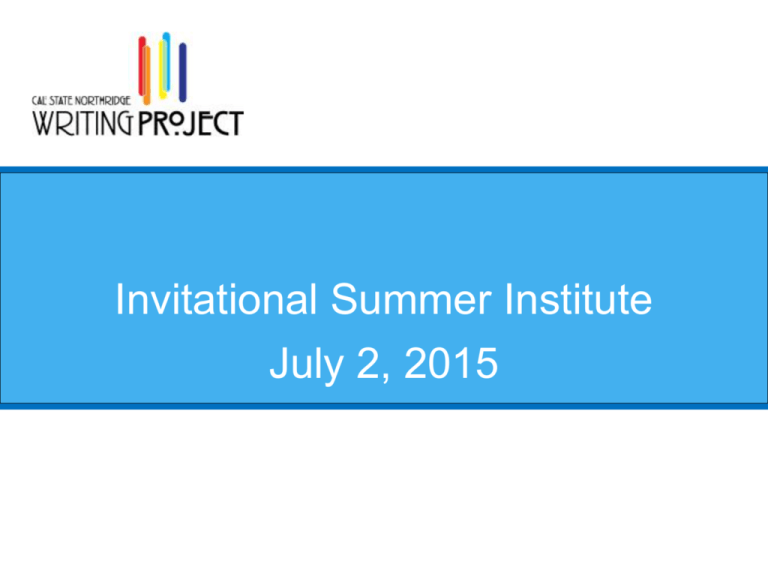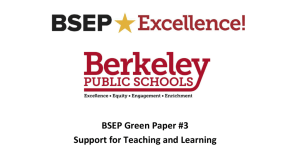Day 8 July 2
advertisement

Invitational Summer Institute July 2, 2015 Agenda Time Event 9:00-9:15 Daily Log, Author’s Chair 9:15-10:30 Francisco Tamayo-Teaching Writing as Social Justice 10:30-10:45 BREAK 10:45-11:15 Demonstration Response 11:15-12:00 ELD Standards 12:00-1:00 Lunch Demo Lesson coaching 1:00-2:15 Rosemary Mitchell-???? 2:15-2:45 Demonstration Response 2:45-3:25 Writing Groups 3:25-3:30 Wrap–up 9:00-9:15 Daily Log: Author’s Chair T-shirt orders… Inquiry groups? Looking at student work on Wednesday #CWPchat on Sunday, 07/05, at 9 a.m. If you are interested in participating in the California Writing Project chat, it is this Sunday, 07/05, at 9 a.m. Follow the hashtag #cwpchat on Twitter For more information on how to participate in a Twitter chat, visit (link also on wiki) http://twitter.about.com/od/twitterglossary/a/How-To-Twitter-Chat.htm Teaching Writing as Social Justice Francisco N. Tamayo francisco.tamayo@csun.edu Classroom Demographics: I teach the stretch writing courses offered in the Department of Chicana and Chicano Studies. The majority of my students are representatives of America’s people of color—Chicana/o and Latina/o. Many are transnational, (border-crossers, always on the move); who are constantly forging difference in meaning as they shuttle across their intersectional ties (race, class, gender and sexuality); they are multilingual, (performing in their home languages); they go through a labor intense process to negotiate meaning across a hegemonic influence of Standard English, and they are also language-minoritized students, (those who have been socialized to believe that they are limited speakers of American English) because their language differences have been seen as personal deficits unsuitable for formal academic purposes. Background: The first graded essay that I assigned is the Literacy Autobiography Essay. In this assignment, students recount their literacy development; for example, if they grew up in a bilingual/multilingual setting how did they manage to negotiate their literacy skills from their home languages to Standard English and vice-versa. They address a serious of questions like, do you think that by being bilingual/multilingual, it has obstructed your learning of academic literacy?; what has the potential to give away, a rejection of ethnicity and/or cultural identity to fully assimilate into academic discourse?; are you the language broker in your family (the translator)? Background: What follows is a series of scaffolding activities to enter conversations about the role of language difference in transnational and multilingual contexts of teaching, learning, and literacy practice in writing. “Man Disrupts Iowa Kindergarten Concert with ‘English Only’ Chant” http://www.huffingtonpost.com/2015/04/27/english-onlychant_n_7151436.html Let’s Write: (10mns.). Write about your running thoughts? Discussion exercise: Please share your running thoughts with a peer. Now, let’s evaluate the news video by addressing the circumstances in which meaning is communicated (rhetorical situation). Rhetorical Situation: (the circumstances in which meaning is communicated) Evaluating news video: – Purpose: Why was the video created (news networks/TV)? What messages are sent by this video? – Content: Is this news video organized and focused on a particular topic/theme? – Audience: To what type of viewer is this news video directed (general viewers, students: elementary, high school, postsecondary, and/or post-baccalaureate)? – Usefulness: How can this news video be used to support an argument(s), refute an argument(s)? Discussion exercise: – With a partner discuss how making use of the rhetorical situation can create meaning. Record your responses. Individually, you will write a short summary without adding and/or deleting anything from the original video. Share out of summaries… LETTER TO SOCIETY You tell me that I am a criminal. You say what I am is no good. That I should be like you so that I may be a good citizen. I have been told these things all my life. My teacher doesn’t want me to speak Spanish because it is no good. I should not be a Catholic because it is no good. I should not have brown skin because it is no good. I should not be loyal to my friends because it is no good. I should not be so clannish because it is not the American Way. I now speak only English, I am no longer Catholic, I have quit being loyal to my friends, and I am no longer clannish. I have changed everything but the color of my skin. And what have I become; a brown man who has no belief in god, cannot speak his parents’ language, who has become a traitor to his friends and an outcast of my people. I have tried to be like you and now you tell me that I am a criminal. Isn’t this what you wanted, or is it because I couldn’t change the color of my skin that I am still no good? -Tony “Chato” Estrada (qtd. in Literatura Chicana: texto y contexto 32). Annotating the Text Scaffolding Exercise: Have students annotate the poem Try to identify the main points/thesis. Write short comments and questions in the margins. Circle unfamiliar words. Note passages where you agree/disagree with the author. Note places where the same idea occurs more than once. Highlight or underline material that you think is significant. Annotating the Text Discussion Exercise: After annotating the text have students record what thoughts might be going through their minds in reference to the poem. After recording their viewpoints have them share these same viewpoints with a partner. Annotating the Text Let’s Write Exercise: Based on the meaning created by the annotation of the poem, have students write a summary/claim statement by following the writing recommendations in, They Say-I Say, “The Art Summarizing.” Break Demonstration Lesson Response DOUBLE THE WORK Identifying the Major Challenges to Improving Literacy in Adolescent ELLs 1. Lack of Common Criteria for Identifying ELLs and Tracking Their Academic Performance 2. Lack of Appropriate Assessments 3. Inadequate Educator Capacity for Improving Literacy in ELLs 4. Lack of Appropriate and Flexible Program Options 5. Limited Use of Research-Based Instructional Practices 6. Lack of a Strong and Coherent Research Agenda for Adolescent ELL Literacy English Language Development Standards Quick Write Take 5 minutes to write down what English language learners need to become successful writers. Former ELD Standards Beginning Early intermediate Intermediate Early advanced Advanced With the categories: Speaking, Listening, Reading & Writing New ELD Standards Emerging Expanding Bridging New ELD Standards They are written to be: Fewer Clearer Higher Overview of the CA ELD Standards and Descriptors Activity Decide on one specific grade for the lesson Pairs or triads will develop a writing lesson that includes the components of the new ELD standards Decide on one proficiency level for the lesson (emerging, expanding, bridging) Groups: Remember: this is a writing assignment! Elementary School Middle School High School Be ready to share!!! Let’s Share Our Ideas Exit ticket for the lesson 5 minute quick write: How will these standards correspond to the CCCSS? Theory to Practice: What constitutes aligned instruction? CCCSS ELD Overlaps? – – – – Intention? Content? Emphasis? Pedagogy? Theory to Practice: Application Identify a lesson that you have taught and are likely to teach again this year. What are the learning outcomes? Identify the CCCSS focus standards that you will address. Identify the ELD standards that you should address. Using the lesson plan form (or another format of your choosing) write the lesson. Prepare to share. Rosemary Mitchell Demonstration Lesson Response Writing Response Groups For Next Time… Sunday, July 5th at 9:00 am join the CWP Twitter Chat if you can… Next week: Writing to Read (executive summary) Pathways to the Common core







